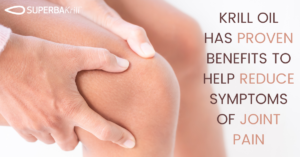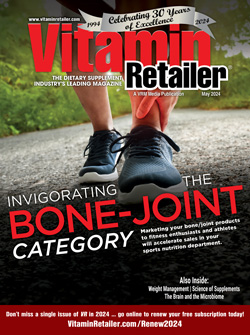Vitamin Retailer (VR) reached out to Richard Passwater, Jr., Product Education Director for Monroe, Washington-based BioMinerals (naturalfactors.com) to discuss the joint health supplement category.
VR: What is the current state of the market for joint health products?
Passwater: In my opinion the joint health market is continuing to become more holistic health oriented. Researchers as well as the general public are becoming increasing aware that joint health is multifactorial and significantly impacted by overall health. I see this mindset evolution occurring in scientific research communities and with consumer behavior.
The first phase of the evolution, in my opinion, is the increased tendency to view joints as holistic muscular-skeletal units. As an example, a joint is a functional unit composed of articulating bones, cartilage, tendons, ligaments, the synovial capsule, synovial fluid, the muscles that effect movement, and the nerves that control movement. Accurate, controlled movement relies on each of these components working correctly. If any component is dysfunctional, the whole structure will be dysfunctional.
I think the evolution’s next phase is the increasing focus on collagen metabolism. All muscular-skeletal units are collagen-based tissue. As an example, the body’s almost 900 ligaments are 70-90 percent collagen, tendons are generally 80-90 percent collagen, cartilage is often about 70 percent collagen and bones are about 30 percent collagen.
As with other collagen-based tissues; cartilage, ligaments, tendons, and bones must be continuously remodeled or rejuvenated all throughout someone’s life.
As an example, a group of European researchers lead by Prof. Enrique Melendez-Hevia estimates an average person needs to make about 1 pound of new collagen every 5 days to properly remodel, repair and rejuvenate their body. These researchers estimate about 43 percent of the new collagen requirement is to remodel bones and about 24 percent to remodel muscles, tendons, ligaments and cartilage. That’s about a pound of new collagen required seven days to keep joint related components in proper condition.
Historically age, wear-and-tear, injury and disease were generally viewed as the drivers of declining joint health. More recently, I’m seeing joint research solidifying associations between factors impacting systemic collagen metabolism and joint health.
In my opinion some of the leading cause of collagen damage throughout the body are homocysteine, stress hormones, such as cortisol, sugar-driven glycation reactions, advanced glycation end products (AGEs) and oxidative stress. These anti-collagen compounds increase the breakdown of existing collagen in joint tissue thereby increasing the daily requirement for new collagen production.
In the past, I think much of the damage from these anti-collagen compounds was incorrectly assumed to be naturally occurring, unavoidable, irreversible wear and tear. But now I see a clear change in thinking that for many—if not most—people, there are several modifiable biological factors that can addressed to better protect existing joint tissue and facilitate the body’s ability to rejuvenate joint tissue as well.
VR: What joint-health research is the most exciting, briefly?
I enjoy studies where clinical endpoints and biomarkers are measured.
As an example, a new human clinical study published in BMC Musculoskeletal Disorders investigating BioSil choline-stabilized orthosilicic acid shows that in just 12 weeks, this specific complex reduces discomfort and stiffness and improves physical function in men with a moderate to moderately severe problematic knee and decreases biomarkers of cartilage degradation in these men.
A research team led by Professor Piet Geusens M.D. Ph.D. from the Biomedical Research Institute at University Hasselt investigated the effects of ch-OSA on joint health in a multicenter, randomized, double-blind, placebo-controlled study on people with painful knee osteoarthritis (OA). 46 men (average age 61.0 years) completed the study lasting 12 weeks.
Symptoms of problematic knees were evaluated in the participants’ most problematic knee using the validated WOMAC questionnaire. The WOMAC measures joint discomfort, joint stiffness and physical function. It is the “gold standard” assessment tool to gage how knee pain is impacting a person’s quality of life and has been used in over 1,500 studies.
The researchers also analyzed C-telopeptide fragments of type II collagen (CTX-II) and cartilage oligomeric matrix protein (COMP) respectively in urine and serum. CTX-II and COMP are both biochemical markers of cartilage degradation or “fragmentation.”
The investigators found a significant (p<0.05) improvement in men taking ch-OSA compared to men in the placebo group after 12 weeks, respectively for:
• Total WOMAC (a 43 percent improvement for the male ch-OSA group, a significant 26 percent difference compared to the 17 percent improvement in the male placebo group),
• WOMAC stiffness (a 48 percent reduction in stiffness for male ch-OSA group, a significant 35 percent difference compared to the 13 percent reduction in the male placebo group)
• WOMAC physical function (a 42 percent reduction in the difficulty preforming 17 daily tasks for the male ch-OSA group, a significant 25 percent difference compared to the 16 percent reduction in the male placebo group.)
Similar trends were observed with:
• WOMAC pain (a 48 percent reduction in the male ch-OSA group, a 26 percent greater reduction compared to the only 22 percent reduction reported in the male placebo group)
• Subject Global Assessment (a 50 percent improvement for the male ch-OSA group, a 16 percent difference compared to the 34 percent improvement for the male placebo group.)
The change in biochemical markers for cartilage degradation was also significantly different (p <0.05) in men for CTX-II (ch-OSA: +73.4 ng/mmol, +20 percent vs. placebo: +175 ng/mmol, +45 percent) and COMP (ch-OSA: -0.24 ng/mmol, -2 percent vs. placebo: +1.83 ng/mmol, +17 percent). These data show that ch-OSA inhibited the ongoing progression of cartilage degradation in these men.
The researchers believe the observed improvements in this latest knee joint study are likely due to the positive effects of ch-OSA on collagen in joint tissues such as cartilage, ligaments and tendons and on subchondral bone.
VR: Joint health is a family affair—ligaments, tendons, muscles, bone—briefly what are the most important ingredients (and products) for joint health?
BioSil choline-stabilized orthosilicic acid is clinically proven in men to relieve joint discomfort, increase flexibility, increase range of motion, and improve cartilage condition.
To accomplish controlled and fluid movement, a team of different collagen dependent connective tissues such as bones, cartilage, ligaments, tendons and muscles must all work together in unison. A failure of any tissue to perform properly can limit a person’s ability to move, cause pain during the movement and/or trigger inflammation. And even worse, the failure of one tissue to perform as expected can cause damage to other tissues involved. The bottom line is your ability to move is only as strong as the weakest link in the movement cycle and all these links are dependent on the quality of their collagen.
BioSil helps stimulate new collagen production by activating and supporting enzymes used to make collagen. BioSil also helps protect collagen by neutralizing homocysteine, a metabolite that destroys collagen throughout the body and suppresses new collagen production. Emerging research also shows that BioSil may also help protect collagen from the stress hormone cortisol.
In addition, glycosaminoglycans such as hyaluronic acid and proteoglycans such as lubricin and aggrecan also greatly influence joint health. (Hyaluronic acid and lubricin make up much of the synovial fluid that cushions and lubricates and nourishes tissues in many joints. Aggrecan helps cartilage withstand compressive loads.) BioSil can positively influence glycosaminoglycans and proteoglycans by binding to them and improving their structural properties.
This is particularly important in joint health because cartilage is avascular tissue meaning that it doesn’t receive direct blood supply from blood vessels. Rather, cartilage is dependent on the quality and quantity of synovial fluid surrounding it to provide it with the nutrients it needs to survive and to carry away the waste products it produces. So, nutrients such as choline-stabilized orthosilicic acid that can positively interact with and improve the condition of the glycosaminoglycans in synovial fluid are very helpful to maintain cartilage tissue.
VR: Consumers naturally want more bang for their buck—and synergistic blends of multiple ingredients are often preferred to single-ingredient products. What blends should retailers be aware of now?
The condition of any joint tissue at the end of any day is a factor of (1) its’ condition at the start of the day, (2) the damage it is subjected to during that day and (3) how well the body can rebuild it during that day.
Ideal joint health protocols address both sides of the equation; protecting existing joint tissue while also helping to rebuild new joint tissue.
BioSil is a great example. BioSil® helps stimulate new collagen production by activating and supporting enzymes used to make collagen. BioSil also helps protect collagen by neutralizing homocysteine, a metabolite that destroys collagen throughout the body and suppresses new collagen production. Emerging research also shows that BioSil may also help protect collagen from the stress hormone cortisol.
VR: As consumers move farther and farther away from the horse pills of yore, what delivery forms are the most popular today, and why?
We recently introduced BioSil vegan liquid capsules. Patent-pending technology now allows Bio Minerals to directly fill clinically proven, liquid choline-stabilized orthosilicic acid, the active nutrient-complex in BioSil, into very small size-3 plant-based vegan capsules. These new BioSil liquid vegan capsules are less than half the size of the first generation BioSil capsules and elegantly display the liquid BioSil they contain.
We feel these features are important because our market research suggests that many modern supplement users prefer smaller pills than those historically sold in the specialty health food stores; and in addition, that a significant and growing number of consumers prefer supplements in a liquid form.
The first generation BioSil capsules also contain liquid BioSil, but the liquid is in the form of micro-droplets sprayed onto solid plant fiber beadlets. The user cannot see the liquid which too often creates confusion. With our new liquid capsules, the user can easily see the liquid.
VR: Where do you predict the joint health market will go over the next 1-5 years?
I believe the joint health market will continue to evolve focusing more on holistic, overall health. And that it will continue to increasingly focus on supporting collagen production while simultaneously preventing joint damage from a multifactual group of collagen-destroying compounds such as homocysteine, stress hormones, such as cortisol, sugar-driven glycation reactions, advanced glycation end products (AGEs) and oxidative stress.












